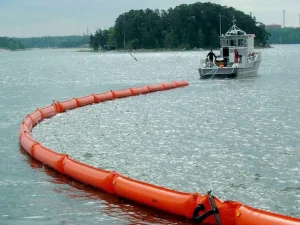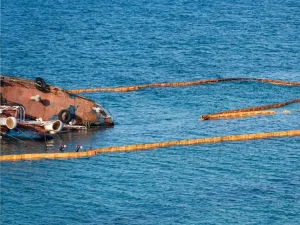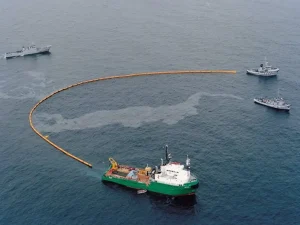Olie is een van de belangrijkste oorzaken van verontreiniging van waterlichamen. De mariene industrie is echter een belangrijke bron van olievervuiling in oceanen. Ze maken gebruik van zeeschepen die olie in de oceanen lozen. Om dit probleem aan te pakken, komen er olieabsorberende booms. Maar de vraag rijst: Hoe werken olieabsorberende booms?
Het is cruciaal om hun werk te kennen, want ze redden het leven in zee. HOE? Olie vormt een laag op het wateroppervlak. Deze laag belemmert zonlicht om diep te reiken en zorgt ervoor dat vissen sterven. Deze uitputting van het zeeleven heeft op de een of andere manier ook invloed op ons milieu. Ben je nieuwsgierig naar deze sorbent booms? Laten we de basisprincipes van hun werk bespreken en hun werking begrijpen.
Overzicht van olieabsorberende gieken

Olieabsorberende gieken zijn buisvormige structuren die olie uit water verwijderen. Ze zijn gemaakt van polypropyleen, dat oleofiel en hydrofoob is. Met andere woorden, het trekt olie aan en stoot water af. Door deze eigenschap kunnen ze drijven en olie in grote hoeveelheden opvangen. Dankzij deze eigenschap kunnen ze drijven en lange tijd olie in grote hoeveelheden opvangen.
Elke olieabsorber heeft echter een beperkte capaciteit om olie op te slaan. Als hij vol olie zit, is het cruciaal om hem te vervangen. Anders zal het zinken en alle opgeslagen olie in het water laten lopen. Dit kan het hele proces beïnvloeden. Bovendien zijn ze verkrijgbaar in verschillende maten voor verschillende waterlichamen.
Olieabsorberende booms vangen niet alleen water op, maar voorkomen ook dat het zich verspreidt. Wanneer ze in het water worden geplaatst, omringen ze olievlekken. Daarom zijn ze effectief voor grote watermassa's, zoals oceanen. Ze worden dan ook veel gebruikt door de maritieme industrie.
Olieabsorptiemiddelen moeten sterk zijn om bestand te zijn tegen ruwe omgevingen. Ze moeten robuust zijn en mogen niet scheuren. Daarom wordt bij de productie de voorkeur gegeven aan synthetische vezels. Het is niet alleen een sterk materiaal, maar ook milieuvriendelijk. Je kunt het bijvoorbeeld recyclen en hergebruiken.
Onderdelen van olieabsorberende gieken

Olieabsorberende gieken bestaan uit verschillende onderdelen. Al deze onderdelen spelen een rol in hun efficiënte werking. Onthoud dat je de goede werking niet zult begrijpen zonder de onderdelen te kennen. Hieronder worden verschillende belangrijke onderdelen van olieabsorptiegieken besproken.
- Buitenstof: De buitenste stof is het buitenste deel van de olieabsorberende stof. Alle andere onderdelen zijn eraan bevestigd. Het zorgt voor de efficiënte werking van oliebomen en is gemaakt van stevig materiaal om druk- en temperatuurschommelingen te weerstaan.
- Absorberende kern: De absorberende kern is de laag onder de buitenstof. Deze is gemaakt van polypropyleen dat zoveel mogelijk olie absorbeert. Voor een efficiënte werking absorbeert het geen water.
- Drijfelementen: Drijfelementen zijn aanwezig in de binnenkern van de olieabsorptiemiddelen. Ze helpen de oliebollen om plat op het wateroppervlak te blijven liggen. Ze hebben voldoende capaciteit om de maximale hoeveelheid olie vast te houden.
- Connectoren en bevestigingsmiddelen: Oliebomen variëren in grootte. Grote watermassa's worden verbonden om een groter gebied te bestrijken, wat hun werk versnelt. Vergeet niet dat aan beide uiteinden van elke olieabsorber verschillende verbindingsstukken zitten. Ze hebben de vorm van clips, touwen of haken.
- Eindkappen en naden: Einddoppen voorkomen dat olie wegloopt. Ze fungeren als deksels en zitten aan de uiteinden van oliekokers. Zorg ervoor dat ze goed zijn afgesloten en bestand zijn tegen de interne druk van de olie.
Hoe werken olieabsorberende gieken?

Heb je het basisconcept begrepen en ben je vertrouwd geraakt met de componenten van deze gieken voor zeeschepen? Vast wel! Wil je weten hoe ze nu werken? Onthoud dat hun werk niet eenvoudig is. Het bestaat uit een reeks opeenvolgende stappen. Laten we elke stap in detail bekijken.
1- Inzet en insluiting
Het is de eerste en cruciale stap in de werking van olieabsorberende gieken. Oliebomen van verschillende grootte worden verplaatst naar gebieden met aanzienlijke olielekkages. Maritieme industrieën moeten olie verwijderen uit grote watergebieden, dus worden deze olieschermen verbonden met bevestigingsmiddelen.
Wanneer ze in watermassa's worden geplaatst, vervullen ze de functie van ontplooiing en insluiting. Dit proces omvat het omringen van olielekkages. Wanneer olieschermen bijvoorbeeld op het wateroppervlak drijven, vormen ze een omheining rond olievlekken. Deze omheining voorkomt dat de olie zich verspreidt en vermindert de extra inspanningen.
2- Olieabsorptie
Na inzet en insluiting begint het olieabsorptieproces. Zoals ik hierboven al zei, zijn oliebommen gemaakt van bepaalde goedkeuringselementen. Deze elementen bevinden zich in het hoofdlichaam en voeren de taak van olieabsorptie uit. Hoe absorberen ze olie? Ze zijn gemaakt van synthetische vezels.
Synthetische vezels staan bekend om hun dubbele functionaliteit van hydrofoob en oleofiel. Dit betekent dat oliebomen alleen de olie absorberen en het water achterlaten. Dit proces maakt het gemakkelijk voor oliebomen om lange tijd te blijven drijven. Toevoeging van water kan ze namelijk zwaar maken en laten zinken.
3- Drijven op water
De oliebollen zijn licht van gewicht en blijven drijven op het wateroppervlak. Ze blijven lange tijd drijven en de olie opvangen. Mariene industrieën voegen soms extra drijfmiddelen toe om hun drijfvermogen te vergroten. Ze voorkomen dat de oliebommen na verzadiging met olie gaan schillen. Bovendien zorgen ze er ook voor dat golven en schokken het drijven van de oliebommen niet beïnvloeden.
4- Verzadiging en vervanging
Ik zei hierboven al dat elke olieabsorberende giek een beperkte capaciteit heeft om olie op te slaan. Zodra de capaciteit is bereikt, bereiken ze het verzadigingspunt. Dit betekent dat ze de maximale hoeveelheid olie hebben geabsorbeerd en geen capaciteit meer over hebben. Als olieschermen per ongeluk deze grens overschrijden, beginnen ze olie af te tappen. Daarom worden oliekokers onmiddellijk na de olieverzadiging vervangen door nieuwe.
5- Verwijdering en reiniging
Zoals ik hierboven al zei, worden oude olieschermen vervangen door nieuwe. Hier rijst de vraag: Waar gaan de oude olieschermen naartoe? Ze worden weggegooid of hergebruikt, afhankelijk van de situatie. Sommige olieschermen zijn bijvoorbeeld niet bestand tegen zware omstandigheden. Daarom worden ze door de scheepvaartindustrie na één keer gebruik weggegooid. Andere soorten spuitbomen worden echter hergebruikt nadat ze zijn schoongemaakt. Een goede reiniging verbetert hun functionaliteit.
Soorten olieabsorberende gieken
Er zijn verschillende soorten olieabsorberende gieken. Op basis van watermassa's worden olieabsorberende gieken echter in drie soorten ingedeeld. Laten we elk type en zijn specialiteit bespreken.
1- Marine gieken
Vooral de maritieme industrie gebruikt deze olieschermen. Ze zijn gemaakt van robuust materiaal dat bestand is tegen de zware omstandigheden van oceanen. De gieken zijn voornamelijk groot, maar er kunnen er veel aan elkaar worden gekoppeld tot de gewenste lengte. Bovendien maakt hun grote omvang het moeilijk om ze te verplaatsen. Daarom gebruiken ze milieuvriendelijke materialen en gaan ze enkele maanden mee in de oceaan.
2- Rivierbomen
Rivierbomen verwijderen olielekkages uit verschillende rivieren. Ze zijn speciaal ontworpen voor de rivieromgeving. Rivieren variëren bijvoorbeeld in breedte en diepte. Daarom zijn deze olieschermen flexibeler. Ze kunnen effectief werken in die verschillende dieptes en breedtes. Bovendien zijn ze kleiner dan scheepsbomen, waardoor ze gemakkelijk te hanteren en te verplaatsen zijn.
3- Havens Booms
Deze oliedammen worden gebruikt om rustig water te beschermen tegen olievervuiling. Je hebt vast wel gezien dat de zeekusten ernstig vervuild zijn door olie. Het zijn parkeerterreinen voor zeeschepen en ander verkeer. Daarom is het cruciaal om ze schoon te maken om ons milieu te redden. Hiervoor worden havendammen gebruikt.
Havenbomen hebben een rechtlijnig ontwerp omdat ze niet worden geconfronteerd met zware golven en sokken. Daarom gaan ze lang mee en verzamelen ze een grote hoeveelheid olie. Bovendien zijn ze eenvoudig te vervangen en te verplaatsen.
Voordelen van olieabsorberende gieken
Olieabsorberende gieken hebben buitengewone eigenschappen en functies. Ze maken het gemakkelijk om vervuild water grondig te reinigen en bieden verschillende andere voordelen. Laten we een korte blik werpen op deze voordelen.
- Je weet dat oliedammen barrières opwerpen rond olielekkages. Dit biedt mariene industrieën een snelle en gemakkelijke manier om uitgestrekte oceaangebieden schoon te maken.
- Olieabsorberende booms zijn veelzijdig inzetbaar in verschillende omgevingen. Ze kunnen effectief zijn in kalme rivieren en oceaanwateren.
- Olielekkages hebben een grote invloed op ons milieu en het zeeleven. Ze kunnen het evenwicht van het ecosysteem verstoren. Maar oliebommen redden tegelijkertijd ons milieu en het zeeleven.
- Ze hebben een eenvoudig ontwerp en zijn gemakkelijk te bedienen. Bovendien kunnen ze dankzij hun flexibele ontwerp gemakkelijk worden verplaatst en aangepast.
- Oliebomen zijn herbruikbaar, gaan lang mee en verlagen de totale kosten. Kleine industrieën kunnen er ook van profiteren.
- Ze zijn gemaakt van synthetische vezels die gemakkelijk recyclebaar zijn. Dit materiaal maakt ze milieuvriendelijk in geval van slijtage.
Veelgestelde vragen
Hoe lang duurt het voordat olieabsorptiemiddel werkt?
Dit hangt voornamelijk af van de lengte en grootte van het water. Een gemiddeld olieabsorptiemiddel doet er echter ongeveer 24-28 uur over om de olie volledig te absorberen.
Is olieabsorptiemiddel brandbaar?
Bijna alle olieabsorptiemiddelen zijn gemaakt van synthetische vezels, die brandbaar zijn. Sommige zijn echter gemaakt van cellulose, dat brandbaar is. Deze zijn echter gemaakt voor speciale omgevingsomstandigheden.
Wat zijn de nadelen van een oliehausse?
Het grootste nadeel van een olieboom is dat hij kan scheuren, omdat hij gemaakt is van lichtgewicht materiaal. Dus zelfs een lichte verzadiging kan ertoe leiden dat olie in het water lekt en het hele proces verstoort.
Conclusie
In dit artikel heb ik de eenvoudig te begrijpen werking van olieabsorberende gieken uitgelegd. Deze olieschermen werken volgens het principe van hechting. Ze zijn bijvoorbeeld gemaakt van synthetische vezels. Deze vezel hecht zich aan de olie door zijn lage oppervlaktespanning en laat het water achter.
Olieabsorberende gieken bestaan uit verschillende onderdelen. Al deze componenten dragen bij aan de efficiënte werking van deze olieschermen. Bovendien zijn er verschillende soorten olieschermen. Deze types zijn specifiek voor verschillende omgevingen. Ze hebben echter eenvoudige en flexibele ontwerpen, waardoor ze gemakkelijk te bedienen zijn.
